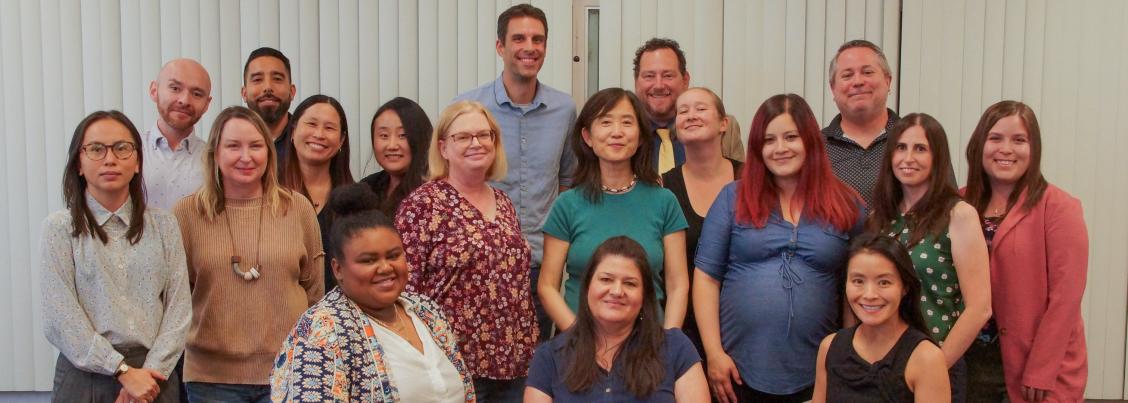
Biography
Education
- Ph.D. University of California, Irvine
- M.A. University of California, Irvine
- B.A. Claremont McKenna College
Courses Taught
- PSY150 - Introduction to Psychology
- PSY321 - Research Methods
- PSY369 - Applied Cognition
- PSY500 - Professional Development
- PSY 581 - Teaching in Psychology
- PSY690A - Advanced Sensation and Perception
Selected Publications and Presentations
Publications
Knox, L., Berzenski, S., & Drew, S. (2023). Measuring Zoom Fatigue in College Students: Development and Validation of the Meeting Fatigue Survey for Videoconferencing (MFS-V) and the Meeting Fatigue Survey for In-Person (MFS-I). Media Psychology.
Doty, TA, Knox, LE, Krause, AX, Berzenski, SR, Hinkel-Lipsker & Drew,SA. (2022) Keep it brief: Videoconferencing frequency and duration as predictors of visual and body discomfort. International Journal of Human-Computer Interaction.
Hinkel-Lipsker, JW, Stoehr, NM, Depur, PL, Weise, MA, Vicente, JA, Drew,SA, & Rogers, SM. (2022) Altered spatiotemporal gaze dynamics during unexpected obstacle negotiation in a fatigued state. Motor Control.
Del Cid, DA, Larranaga, D, Leitao, M, Mosher, RL, Berzenski, SR, Gandhi, V, & Drew, SA. (2020) Exploratory factor analysis and validity of the Virtual Reality Symptom Questionnaire and Computer Use Survey. Ergonomics. 1-27. DOI: 10.1080/00140139.2020.1820083
Drew, SA, Awad, MF, Armendariz, JA, Gabay, B, Lachica, IJ & Hinkel-Lipsker, JW. (2020) A perceptual-motor examination of virtual reality training and real-world transfer. Frontiers in Sports and Active Living, 2, 59.
Magruder, ED, Scott, W, Willard, M, Ruiz-Mesa, K & Drew, S. (2019) Transparency to close opportunity gaps in the largest state system. In M-A. Winkelmes, A. Boyle. & S. Trapp (Eds.), Transparent Design in Higher Education Teaching and Leadership. (pp. 166 – 184) Sterling, VA: Stylus Publishing, Inc.
Drew, SA, Awad, JF, Hackney, BC & Fenn, E. (2018) Orange is Less Than Green: An Examination of Bidirectionality in Grapheme-Color Synesthesia. Perception. 47(8): 881-891
Liu, C, Drew, SA, Borsting, E, Stark, L, Escobar, A & Chase, C. (2016) Tonic Accommodation Predicts Closed-loop Accommodation Responses. Vision Research. 129: 25-32
Borsting, E, Liu, C, Drew, S, Chase, C. (2015) Does somatic amplification effect patient reports of visual discomfort? Vision Development and Rehabilitation 1(2): 135-141
Drew, SA, Borsting, E, Stark, LR and Chase, C. (2012) Chromatic aberration, accommodation and color preferences in asthenopia. Optometry and Vision Science.
Drew, SA, Chubb, CF, and Sperling, G. (2010) Precise attention filters for Weber contrast derived from centroid estimations. Journal of Vision. 10(10): 20
Research Interests
The Visual Information Sciences & Neuroscience (V.I.S.N.) Lab is a cognitive psychology lab with research focused on visual perception, learning, and technology. Our mission adopts an interdisciplinary approach that leverages a unique blend of neuroscience, psychometrics, psychophysics, and optometric measures. Currently, we have several different areas of focus for our research:
Virtual Reality
Virtual reality (VR) systems are becoming more available for people to use and immerse themselves in virtual worlds. Applications have been found across a wide range of disciplines that range from education to healthcare, therapy to marketing. With the rapid increase in usage, it is critical to understand the ocular impacts of system usage.
Augmented Reality
Augmented reality involves using technology to superimpose additional stimuli onto the real world (e.g. Pokemon Go, Snapchat filters). Despite the heavy usage of this technology, little is known about the relationship between this technology and our visual systems
Zoom Fatigue
With the global COVID-19 Pandemic, video conferencing usage has seen a sharp increase that is accompanied by anecdotal accounts of "Zoom Fatigue." This work examines the ocular impact of extensive video conferencing usage.
Asthenopia
When we perform close work, such as reading a text message on a phone, our eyes rotate to keep the object centered on the retina in a process called vergence, and the lens in our eye thickens to allow the target to remain in focus in a process called accommodation. This work examines the relationship between these oculomotor systems and the condition asthenopia, or visual discomfort.
Attention & ADHD
Many forms of attention can be captured using eye-tracking technology and psychophysics. We utilize a variety of methods to examine different dimensions of attention. Additionally, in collaboration with Dr. Gary Katz, we are interested in utilizing eye-tracking technologies to examine ocular behaviors exhibited in individuals expressing ADHD symptoms.
Technology and Learning
With constant technological advancements being used for education, it is critical to understand for technology impacts learning as well as ocular health.
Neuroimaging
Electroencephalography (EEG) records patterns of brain activation. With new mobile EEG systems available on the commercial market, a better understanding of the efficacy of these systems is warranted.




